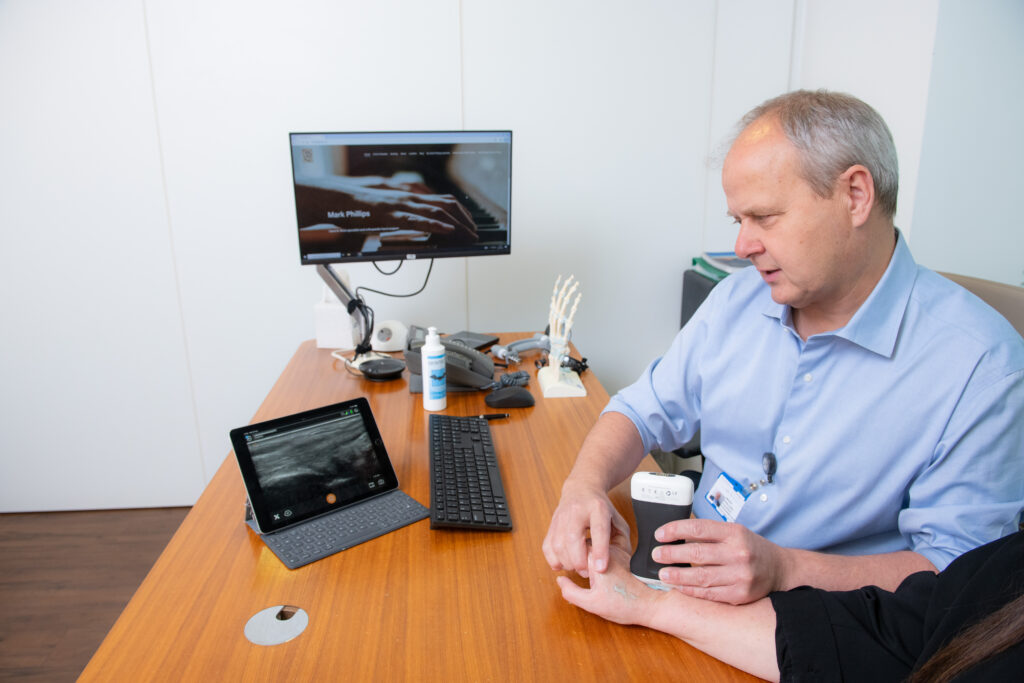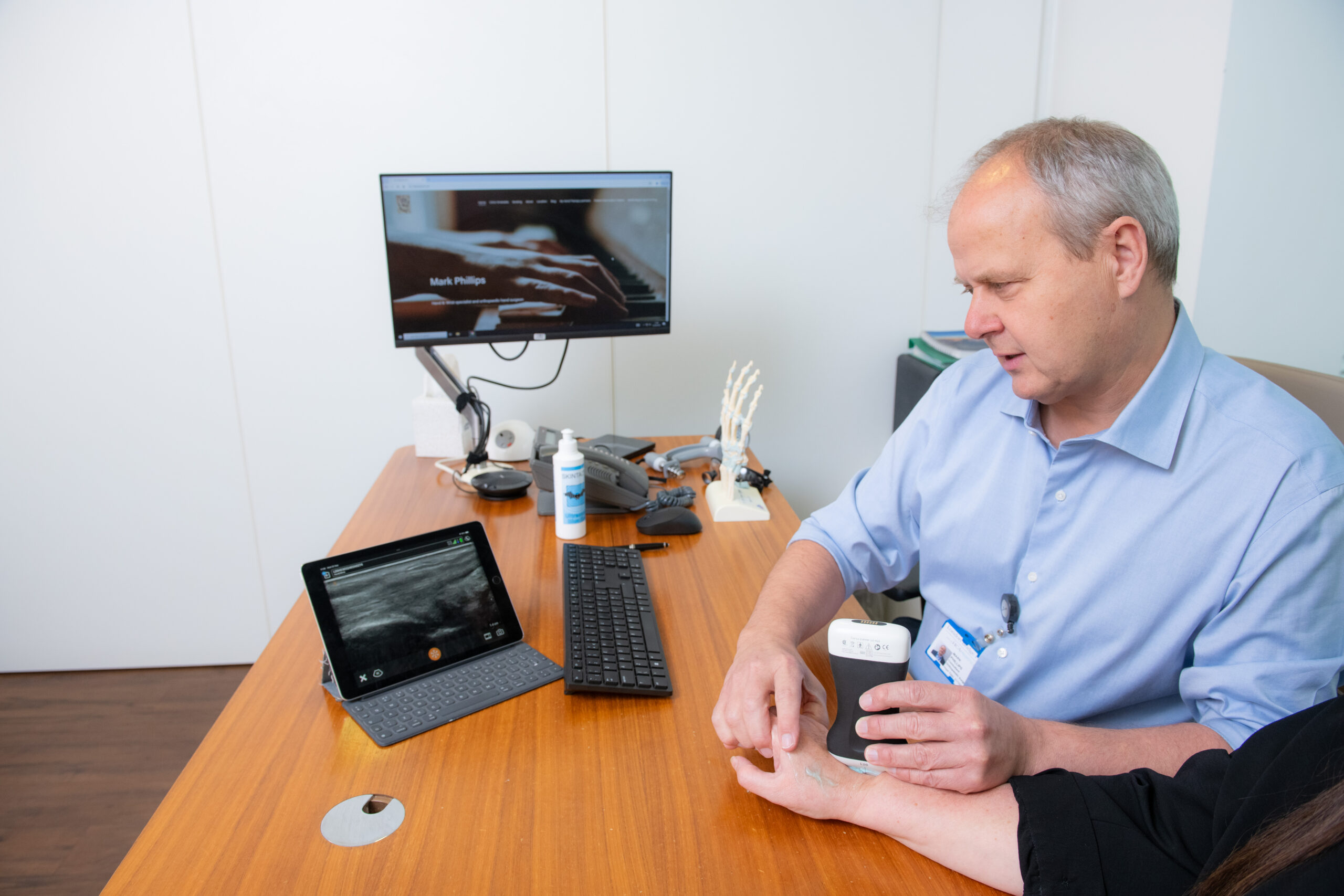We’ve all heard someone say, “I think I have carpal tunnel, my hands are going numb!” Carpal Tunnel Syndrome (CTS) is one of the most well-known conditions related to the hand and wrist, but it’s also one of the most misunderstood. Whether you spend your day typing at a desk, working with tools, or scrolling on your phone, it’s easy to wonder: Is this tingling feeling the beginning of Carpal Tunnel… or something else?
It’s time to set record straight by busting some of the most common myths and questions asked in my clinic about Carpal Tunnel Syndrome and replacing them with facts that can help you better understand the condition, its causes, and what you can do about it.

Myth: Carpal Tunnel Syndrome only affects people who type a lot.
Fact: Typing can definitely be a contributing factor, but it’s not the only one.
Although it’s true that repetitive hand and wrist movements can aggravate CTS, and jobs involving computer use can increase your risk , it is not true that typing alone causes this condition. Carpal Tunnel Syndrome develops when the median nerve, which runs from your forearm into your hand, becomes compressed at the wrist. This can happen for many reasons:
- Repetitive hand use (yes, including typing, but also assembly line work, construction, and more)
- Pregnancy (due to fluid retention)
- Medical conditions like diabetes, rheumatoid arthritis, or hypothyroidism
- Wrist injuries, like fractures or sprains
So, while your keyboard may not be entirely off the hook, Carpal Tunnel isn’t exclusive to the regular typist. People in all kinds of professions, from musicians to mechanics, can be affected.
Myth 2: Carpal Tunnel Syndrome is just a minor inconvenience and will get better by itself.
Fact: If left untreated, Carpal Tunnel Syndrome can lead to permanent nerve damage.
Many people try to “tough it out” or assume the symptoms will go away on their own. But chronic compression of the median nerve can lead to muscle weakness, loss of coordination in the fingers, and even permanent nerve damage if it’s ignored for too long…and it hurts!
If you’re experiencing symptoms like:
- Numbness or tingling in your thumb, index, middle, or part of the ring finger
- Weakness in the hand (e.g., dropping objects)
- Pain that wakes you up at night
…it’s best to get evaluated by your GP or Hand and Wrist Consultant sooner rather than later. Early diagnosis can make a big difference in treatment success.
Myth 3: Surgery is the best treatment option.
Fact: Surgical intervention is often a last-case scenario, especially if the pain and symptoms are not aggressive.
Surgery, specifically Carpal Tunnel release surgery, is still a safe and effective option for severe or longstanding cases, but not everyone needs it!
In the early stages of this condition, many people benefit from conservative treatments such as:
- Wrist splints, especially at night to keep the wrist in a neutral position
- Activity modification to reduce repetitive strain
- Anti-inflammatory medications or corticosteroid injections
- Hand therapy to stretch and strengthen
For mild to moderate cases, these non-surgical options can relieve symptoms and even prevent the condition from progressing.
Myth 4: Carpal Tunnel Syndrome affects the whole hand.
Fact: Carpal Tunnel typically affects only certain fingers.
Right, if you are reading this, take a look at your hand. The median nerve supplies sensation to your thumb, index finger, middle finger, and part of the ring finger. If you’re experiencing numbness or tingling in your pinky finger, it’s likely something else, possibly ulnar nerve compression, also known as cubital tunnel syndrome.
Knowing which fingers are affected can pinpoint the issue and make the diagnosis process quicker. So, pay attention to where the numbness or pain shows up, it’s a useful clue!
Myth 5: You can’t prevent Carpal Tunnel Syndrome.
Fact: You can lower your risk with a few simple strategies.
While you can’t always control risk factors like genetics or pregnancy, you can take steps to reduce stress on your wrists which will help you from worsening symptoms.
- If you’re a regular typer, drawer, musician or manual labourer then one of the best tips will be just to take a break! The main aim is to reduce the strain on your wrists and having regular breaks can really help!
- Stretch your hands and wrists regularly.
- Keep wrists in a neutral position, especially during sleep or while using tools.
- Improve ergonomics at your workstation, invest in a proper keyboard and mouse pad that can relieve the strain on your hand and wrists.
- Use supportive wrist braces if recommended, particularly if you work in a high-risk job.
These small changes can make a big difference over time, especially if you’re in an at-risk group.
Myth 6: Only older adults get Carpal Tunnel Syndrome.
Fact: It can affect people of all ages.
While Carpal Tunnel Syndrome is more common in adults over 40, younger people are not immune! And depending on your job or lifestyle, could be more at risk. In fact, with the increase in technology use and mobile devices, more young adults are experiencing symptoms earlier.
PS. How do your fingers feel when holding your phone and doom scrolling?
Pregnant women are also a unique group: hormonal changes and fluid retention during pregnancy can lead to temporary Carpal Tunnel, which usually resolves after childbirth but still needs monitoring and it doesn’t take away the fact that it can be very uncomfortable.
Finally,
Carpal Tunnel Syndrome is common, treatable, and, with the right approach, very manageable. Some myths may seem obvious to you, but not understanding the basics of Carpal Tunnel can and has prevented people from getting it treated!
If you suspect you might be dealing with Carpal Tunnel Syndrome, come and see me in clinic, where you will get a full diagnosis and a treatment plan suited for you.
Or if you would like to read more on common hand conditions, click here.
Your hands are one of your most valuable tools, take good care of them!






